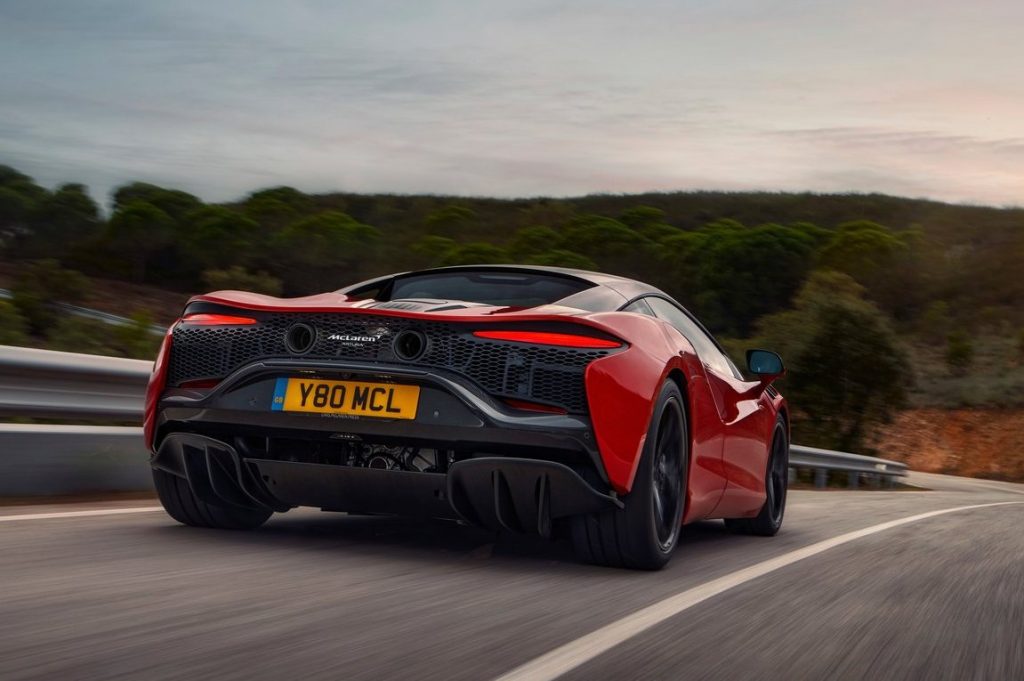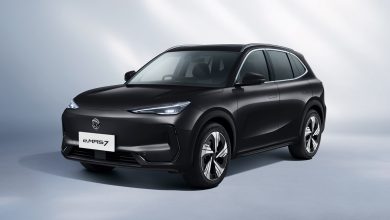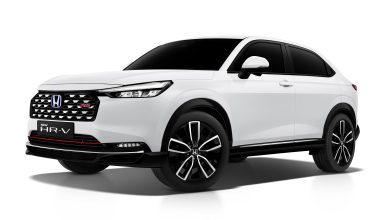McLaren Artura Debuts With A 671 hp PHEV Powertrain

McLaren joins the hybrid supercar party with the twin-turbocharged V6 Artura.
After what was an incredibly long wait after the holy trinity of hybrid hypercars were first unveiled, this (once-innovative) hybrid tech has finally trickled down into the next-generation of supercars. First it was seen in the new Ferrari SF90 Stradale, and now made it into the McLaren’s latest product — the Artura.

For all intents and purposes, this Artura is meant to mark the start of McLaren’s journey towards the hybridisation of its supercar range journey. An all-new naming system that ditches the old alpha-numeric jargon makes clear of that. Having said that, this new landmark supercar however does perhaps look rather similar to its GT and 720S siblings that sandwiches it within the current McLaren lineup.

Nevertheless, beneath that already pretty well-known McLaren silhouette lies is the radical change in the form of that new hybrid powertrain. Starting first on the ICE side of things, the Artura loses two cylinders compared to its other V8-powered siblings and features instead a mid-mounted 3.0 litre twin turbocharged hot-V6 (which revs to 8,500 rpm) that is paired with 8-speed dual-clutch transmission.

Speaking more on this gearbox, this compact transmission interestingly contains no reverse gear, as rearward motion of the Artura is taken care of by the compact axial flux E-motor housed within the transmission. Fed by a 7.4 kWh lithium ion battery pack which gives up to 30 km of pure EV driving, this electric drive motor naturally also contributes a not-insignificant portion to the combined 671 hp and 719 Nm of torque that is sends to just the rear wheels of this new McLaren supercar.
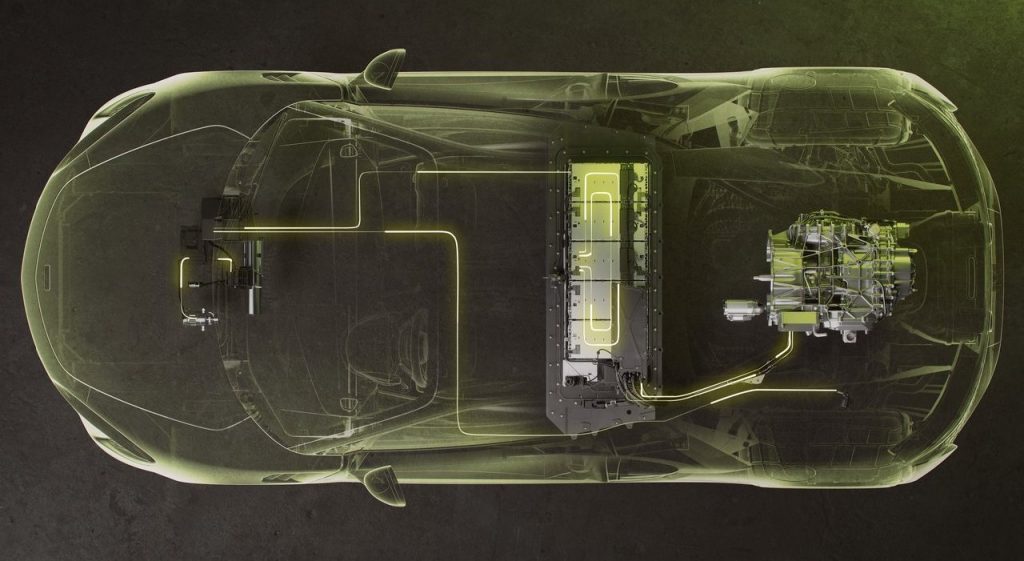
To those who prefer to soak in this power figure in terms of acceleration times, the Artura can manage the century sprint in 3 seconds flat. The 0-200 km/h and the 0-300 km/h times meanwhile are claimed to be 8.3 seconds and 21.5 seconds respectively, with the top speed of this McLaren stated to be an electronically limited 330km/h (205mph).
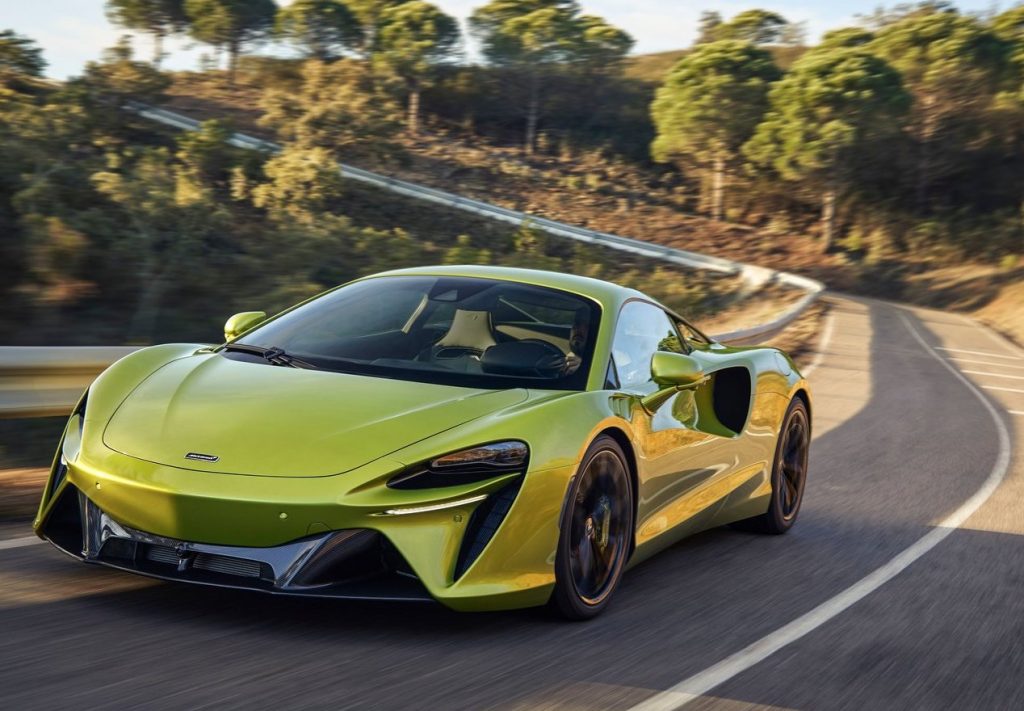
Aside from the new powertrain, there are also several performance highlights that are worth a mention on this new hybrid supercar. These include the standard fitment of electronic differential, a revised suspension setup, updated carbon ceramic brakes and a host of other associated performance enhancing and aero changes. Further details of which can be found in the extremely in-depth press release below.
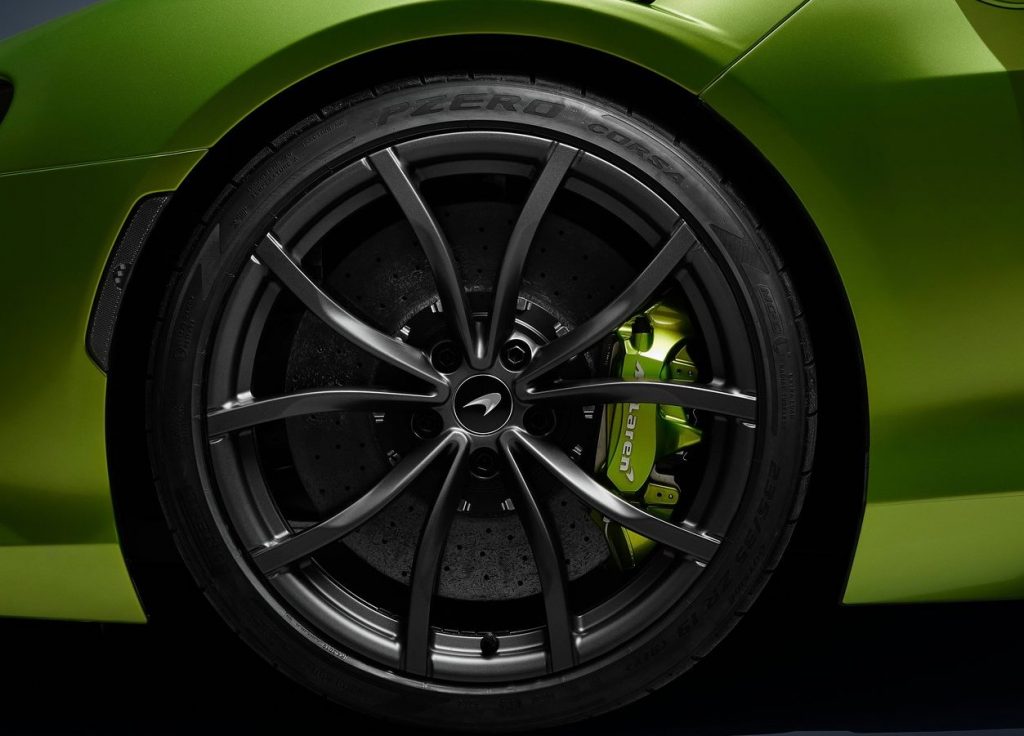
Now whenever topic of hybrids comes about, especially in the case of hybrid supercars, the question of its weight penalty will inevitably be raised. McLaren being McLaren though has managed to negate this weight problem by taking an almost anal approach to shaving every gram out of the Artura.
To that end, the Artura features a brand new lightweight carbon fibre tub that utilises all-new McLaren Carbon Lightweight Architecture (MCLA). The amount of cabling is reduced by 25% thanks to the use of ethernet connectivity. Add to that the other weight saving measures in other parts of the bodywork like the lightweight doors for instance, it therefore all amounts to the Artura’s kerb weight of just 1,498 kg. Or to put it in another sense, nearly as light as a comparable solely petrol-burning supercar.
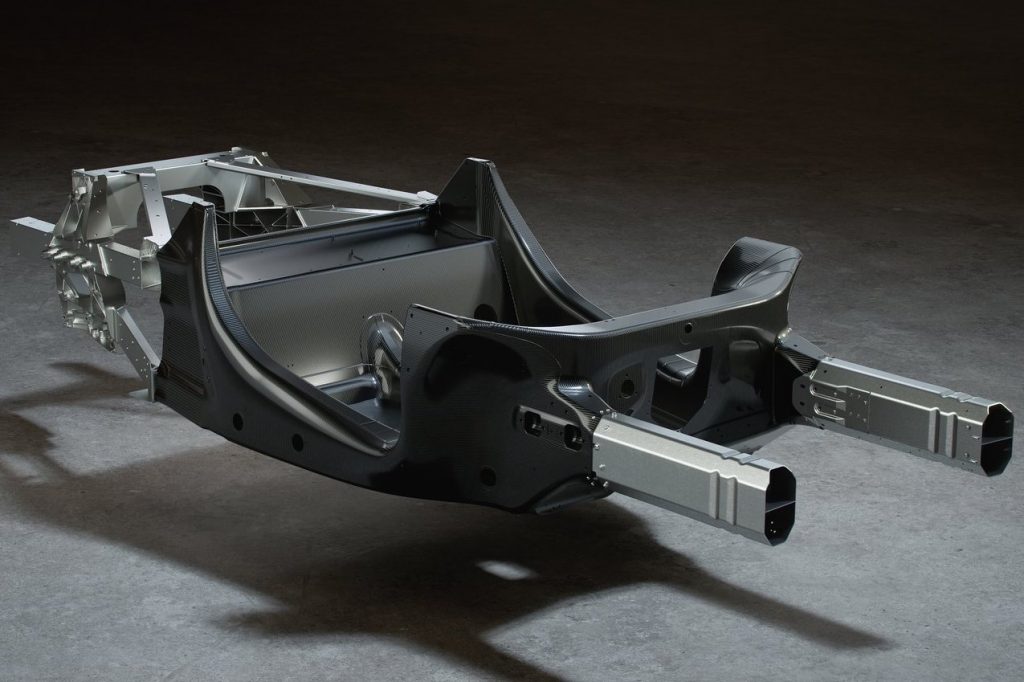
Moving along to the more practical aspects of this lightweight hybrid supercar, the Artura may be lightweight but it isn’t stripped out as it still comes equipped with a slew of active driver aids such as Intelligent Adaptive Cruise Control, Lane-Departure Warning, Auto High-Beam Assist and Road-Sign Recognition. A Bowers & Wilkins sound system, more ergonomic Clubsport seats, as well as Apple CarPlay and Android Auto integration on the second-generation twin-screen McLaren infotainment system are also now available within this revised cabin.

To be available in three trim levels: Performance, TechLux and Vision, prices for the Artura start from £185,500 (RM 1.05 million), with deliveries beginning in the third-quarter of this year. All these new McLaren hybrid supercars come as standard with a five-year vehicle warranty, a six-year battery warranty and 10-year body warranty is standard on every Artura.
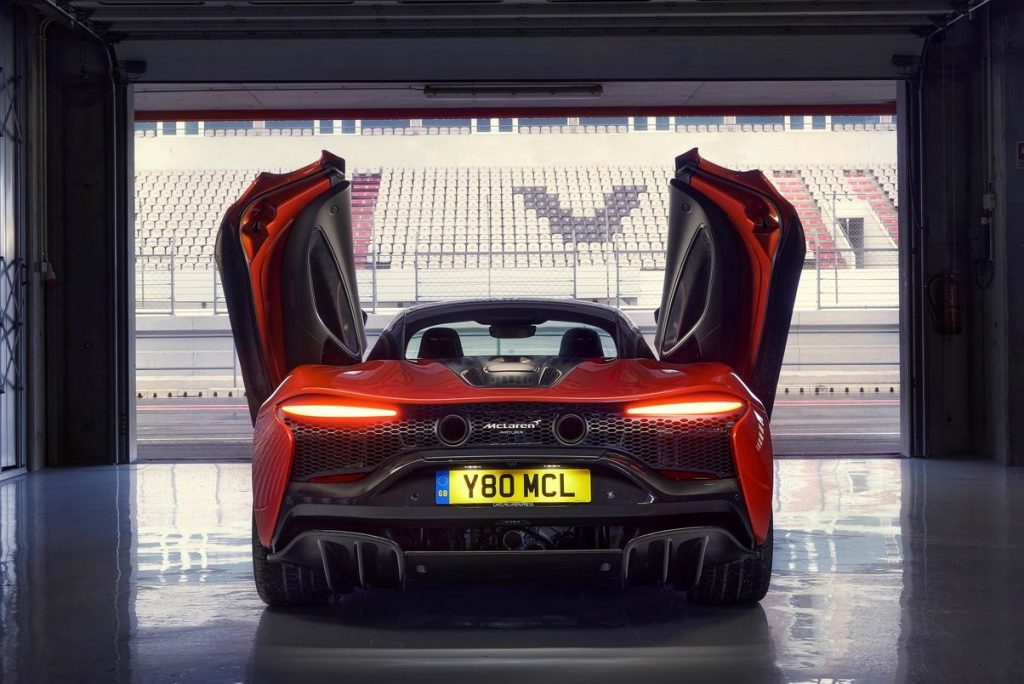
PRESS RELEASE: The all-new McLaren Artura is revealed today, marking the beginning of both a new chapter for the pioneering luxury supercar company and a new era in supercar technology and performance.
McLaren’s first series-production High-Performance Hybrid supercar focuses more than half a century of the company’s racing and road-car experience and expertise into a next-generation supercar that blends ground-breaking technology with McLaren’s dedication to pure driver engagement.
Underpinned by the McLaren philosophy of super-lightweight engineering, the all-new Artura is the distillation of every attribute inherent in a McLaren – distinctive design, unrivalled performance, dynamic excellence and engineering innovation – with electrification now bringing the additional benefits of even faster throttle response, lower emissions and being able to run in pure EV mode for emissions-free journeys of up to 30km.
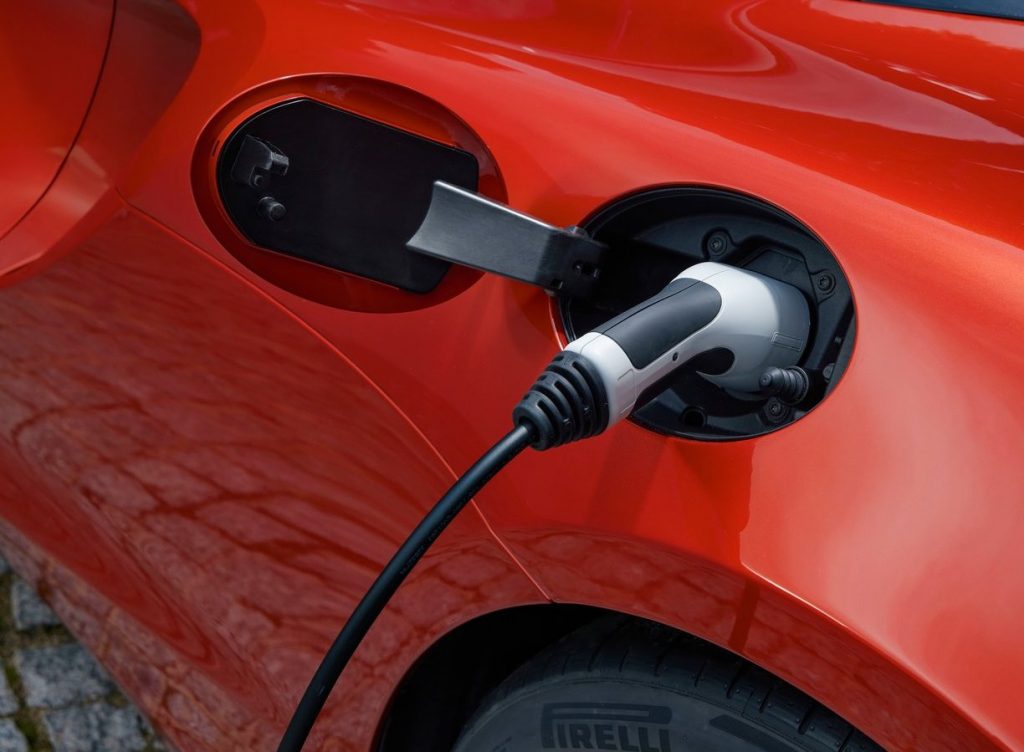
All-new from the ground up, the Artura presented McLaren engineers and designers with new opportunities to innovate, chief among these being how to preserve McLaren’s super-lightweight engineering philosophy when adding hybrid powertrain elements including an E-motor and battery pack.
A demanding programme of weight reduction, encompassing every area of the Artura from the chassis platform – this is the debut of the new McLaren Carbon Lightweight Architecture (MCLA) – through the uniquely compact HPH powertrain system to the weight of cabling used in the electrical systems (where a 10% reduction was achieved), resulted in the Artura having a lightest dry weight of 1,395kg. The total weight of hybrid components is just 130kg (which includes an 88kg battery pack and 15.4kg E-motor), resulting in a DIN kerbweight of 1,498kg which is on par with comparable supercars that do not have hybrid powertrains, giving the Artura a super-lightweight advantage.
“Every drop of McLaren’s experience and expertise has been poured into the Artura. Our all-new, High-Performance Hybrid delivers all of the performance, driver engagement and dynamic excellence for which McLaren is renowned, with the additional benefit of EV driving capability. The introduction of the Artura is a landmark moment – for McLaren, for our customers who will appreciate and enjoy this car on every emotional and rational level, and for the supercar world.”
Mike Flewitt, CEO, McLaren Automotive
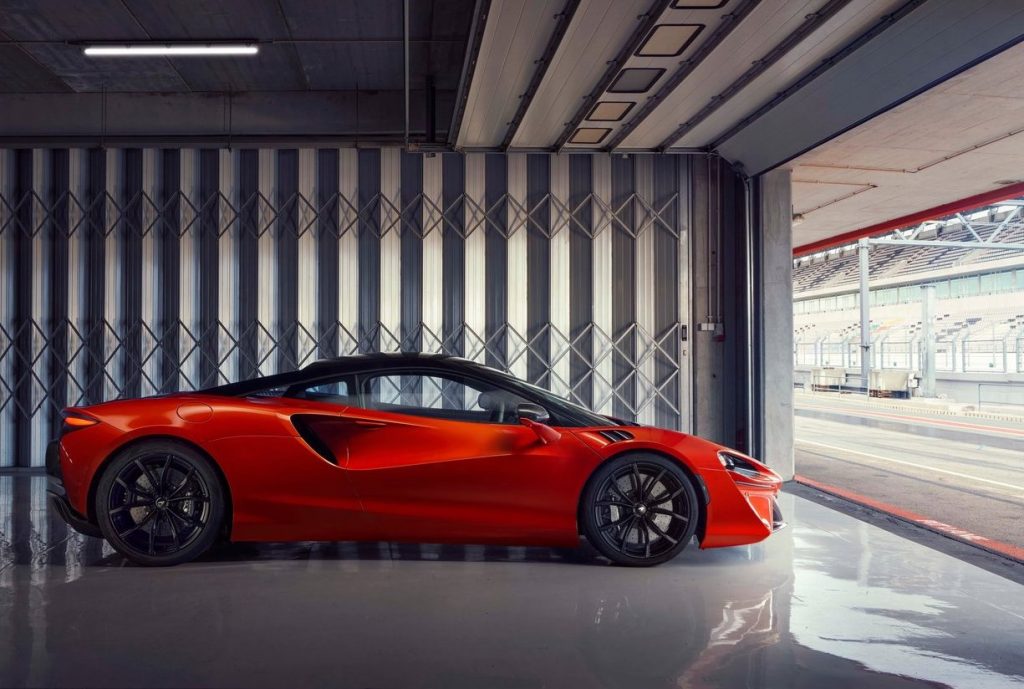
At the heart of the Artura’s powertrain is McLaren’s all-new, 2,993cc twin-turbocharged V6 petrol engine. With a power output of 585PS – nearly 200 PS per litre – and 585Nm of torque, the dry-sump aluminium engine is compact and lightweight; at just 160kg it weighs 50kg less than a McLaren V8 and is significantly shorter, enhancing packaging efficiency.
Designed to run with a Gasoline Particulate Filter to optimise emissions performance, the M630 engine is also extremely refined. The 120° v-angle of the engine, which allows the turbochargers to be positioned within the ‘hot vee’, delivers further advantages in packaging as well as contributing to a lower centre of gravity. The 120° layout increases engine performance by reducing the pressure losses through the exhaust system and allows for a stiffer crankshaft that enables a rev limit of 8,500rpm, maximising performance and driver engagement.
Working in harmony with the new V6 is the Artura’s compact axial flux E-motor, located within the transmission bell housing. Smaller and more power-dense than a conventional radial flux E-motor, it is capable of generating 95PS and 225Nm and boasts a power density per kilo 33% greater than the system used in the McLaren P1. The instantaneous nature of the motor’s torque delivery – known as ‘torque infill’ – is key to the car’s razor-sharp throttle response. Exhilarating ‘off-the-line’ performance sees the Artura achieve 0-100km/h (0-62mph) in just 3.0 seconds, with 0-200km/h (0-124mph) taking 8.3 seconds and 0-300km/h (0-186mph) 21.5 seconds. Top speed is limited to 330km/h (205mph).
The dual propulsion systems are integrated via an engine disconnect clutch, driving an all-new, twin-clutch transmission, which has been developed specifically for the Artura. Despite having one more ratio than the existing McLaren transmission – to optimise power and torque delivery – the lightweight, short-ratio gear cluster is 40mm shorter in length. It also requires no reverse gear – the E-motor takes care of reversing by literally rotating in the opposite direction.
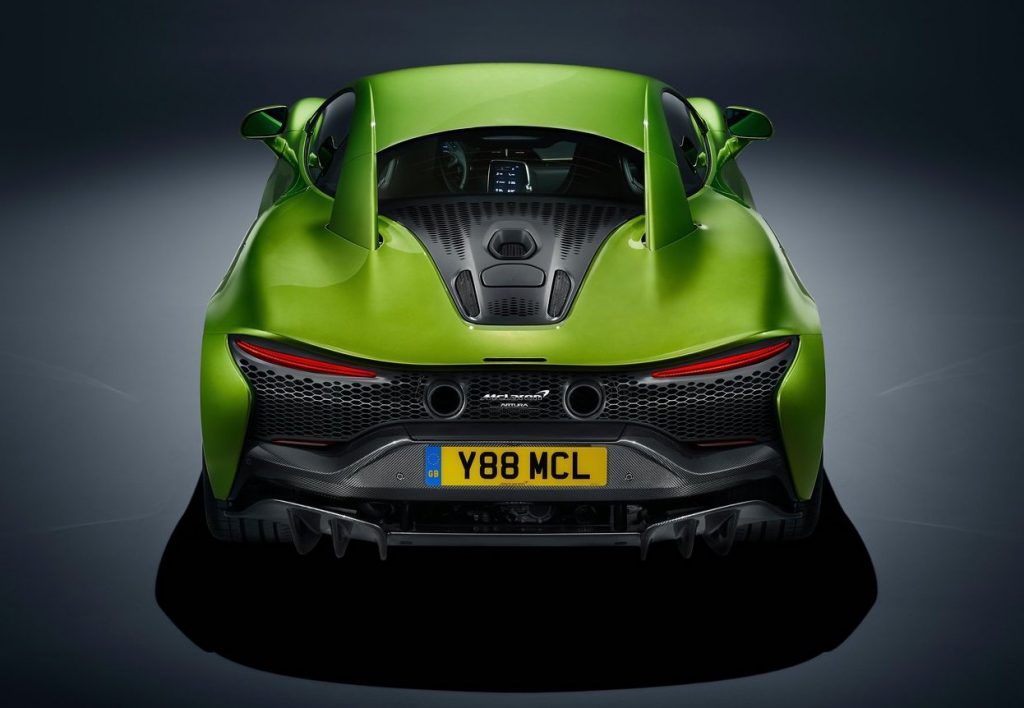
The E-motor is powered by a battery pack comprising five lithium-ion modules, offering a usable energy capacity of 7.4kWh and a pure EV range of 30km. The battery is refrigerant cooled using cooling rails, and the assembly – including a power distribution unit which transfers battery power from the rear of the vehicle to the ancillaries in the front – is mounted on a structural carbon fibre floor. This assembly is then bolted onto the rear base of the monocoque, optimising stiffness, weight distribution and crash protection.
The Artura is designed with full Plug-in Hybrid (PHEV) capability and can be charged to an 80% charge level in just 2.5 hours with a standard EVSE cable. The batteries can also harvest power from the combustion engine during driving, tailored to the driving mode selected.
“From the very beginning of the project, designing and engineering the Artura has been all about challenging ourselves to innovate, pushing and pushing to achieve everything we knew a next-generation, High-Performance Hybrid McLaren supercar had to be. As a result, the Artura is all-new; the carbon fibre monocoque, electrical architecture and the body and interior are new. So too is the V6 engine, the transmission – which also integrates a new type of electric motor for the industry – as well as the rear suspension concept and our first-ever electronic differential.”
Geoff Grose, Chief Engineer, McLaren Artura
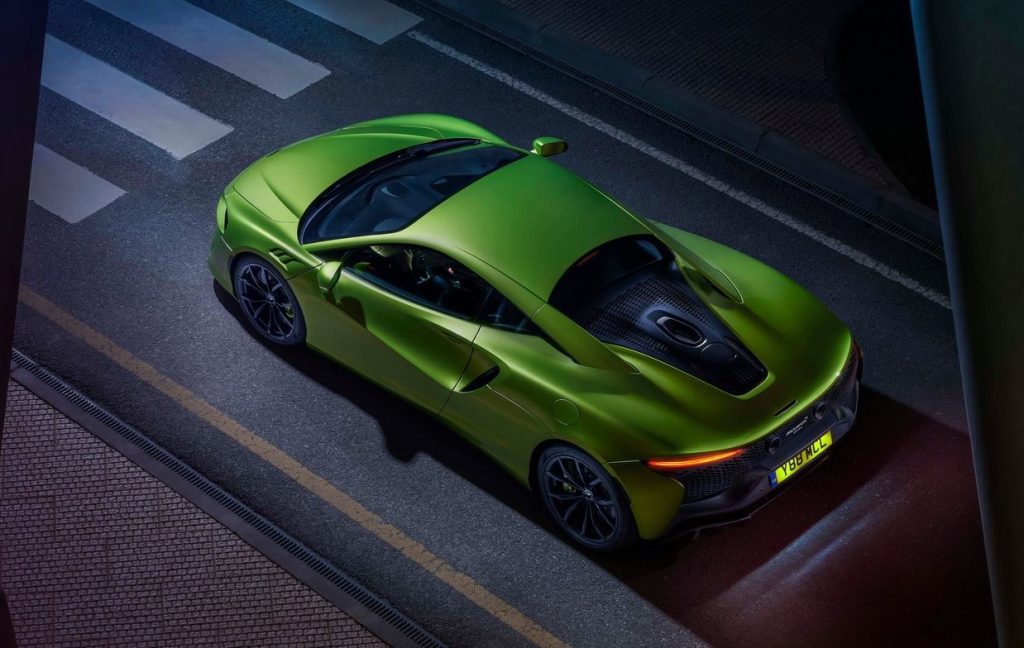
The McLaren Artura is the first model to have the new McLaren Carbon Lightweight Architecture (MCLA) at its core. Designed and manufactured at the McLaren Composites Technology Centre (MCTC) in the Sheffield region, MCLA sets a new standard for McLaren’s advanced flexible chassis design. Optimised for high-performance hybrid applications, it includes a bespoke battery compartment and introduces a ground-breaking domain-based ethernet electrical architecture, along with an electrical heating, ventilation and air-conditioning (eHVAC) system.
The ethernet architecture reduces cabling by up to 25% as well as speeding up data transmission. This also facilitates access to advanced driver-assistance systems (ADAS) including Intelligent Adaptive Cruise Control, Lane-Departure Warning, Auto High-Beam Assist and Road-Sign Recognition as well as Over-The-Air (OTA) software updates.
The engineering artistry beneath the Artura’s skin is complemented by its exterior design. The low-nose, cab-forward, high-tail stance is pure supercar, the drama underlined by the signature McLaren dihedral doors – which open closer to the body and house mirrors that fold in more tightly – and further enhanced by the short wheelbase and low stance.

The overall effect gives the Artura an almost ‘shrink-wrapped’ appearance, evolving a McLaren design approach seen in recent models to a new level. The lithe, technical sculpture has only minimal body shutlines and panel joints, assisted by features such as an entire rear clamshell engineered and superformed as one panel. The shape of the Artura, sculpted to optimise performance and manage airflow for aerodynamic performance and cooling, is driven by the McLaren design principle of ‘everything for a reason’ that is in evidence throughout the car. The centre of the front splitter is an example of this, being the intake for the eHVAC system and also housing the front-mounted radar that forms part of the optional ADAS package.
Inside, the Artura is no less of a revolution, with the cockpit centred more than ever around the driver. The driving mode selection – which retains separate Powertrain and Handling controls – has been moved to the instrument binnacle, which is in turn mounted to the steering column and adjusts with the steering wheel to further enhance driving ergonomics. Consequently, the steering wheel is kept clear of unnecessary switches, however, the driver is still able to adjust driving modes without taking their hands away from the wheel.
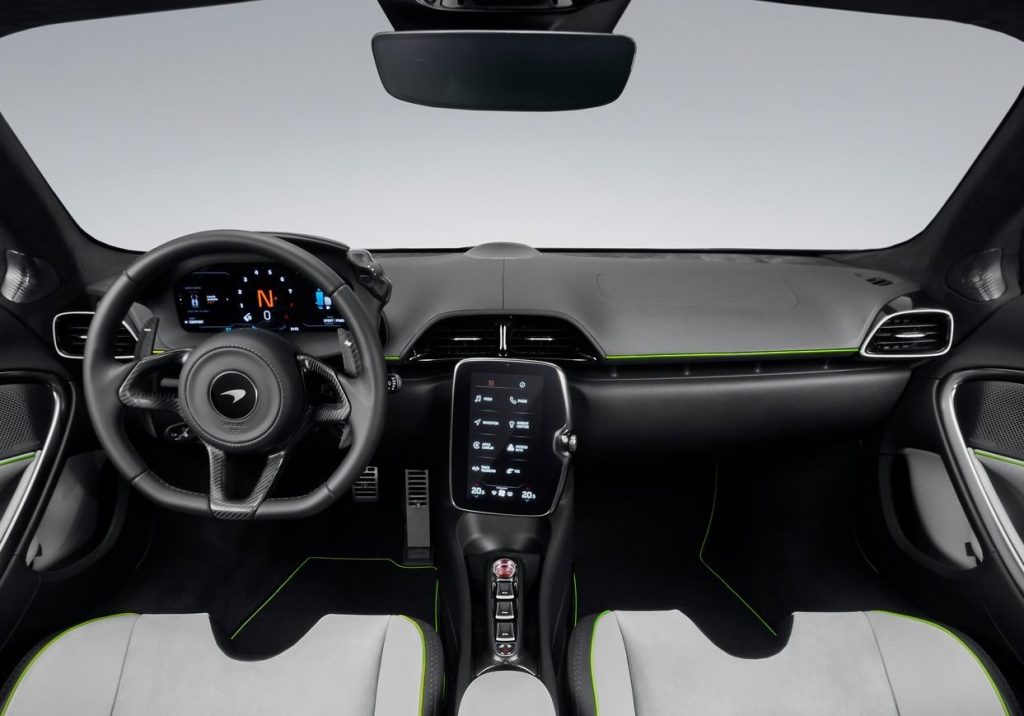
The driver can choose from four Powertrain modes, including an E-mode for 30km of emissions-free, electric-only driving. Designed for mixed driving conditions, Comfort mode maximises range and efficiency, with the combustion engine shut off under 40km/h with the use of an extended stop and start mode but phased in for greater speed and power requirements. In Sport and Track modes, electric power is deployed in an increasingly aggressive manner for low-end response and acceleration (‘torque infill’). Separate handling mode choices adjust damper firmness and the degree of Electronic Stability Control intervention to suit driver preference and weather and road conditions.
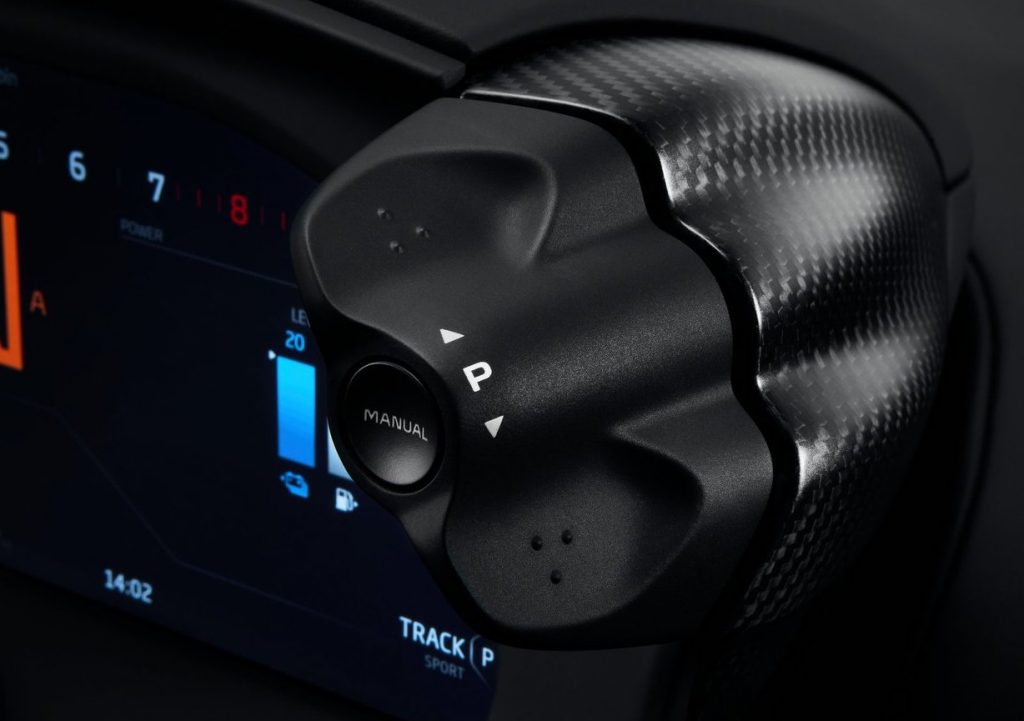
At the outset McLaren designed the Artura to be not only a technological game-changer, but also to stay true to the core McLaren attributes of being incredibly engaging to drive and displaying the highest levels of dynamic ability. Designed to excel on both road and track, the Artura also boasts the dynamic refinement to make serene progress through urban streets in EV mode.
McLaren engineers focused on stability under braking; rear-end controllability; increased grip and optimised aerodynamic downforce – as well as enhanced driver engagement across the board. Key to hitting these goals is McLaren’s first-ever deployment of an electronically controlled differential (E-diff), to independently control torque moving across the rear axle. Lighter, more controllable and smaller than a mechanical locking diff (it fits within the transmission), the E-diff locks and unlocks individual rear wheels to improve traction out of corners.
The innovative rear suspension system, which pairs a top upper wishbone with two lower links and a tie rod in front of the wheel centre, maximises vehicle stability and precision, and reduces understeer out of a corner while accelerating. The wider tyres allow additional stability and better traction performance while the combination of a short wheelbase, E-diff and the physical downforce provided by the integrated rear spoiler and diffuser ensure both incredible agility at low speed and a high level of stability at high speed. The E-diff in particular increases performance and driver confidence when cornering, enhancing traction and reducing levels of understeer.
Dynamic precision is additionally enhanced by Pirelli Cyber Tyre technology. Comprising hardware and software integrated with the Artura’s electronic systems and featuring an electronic ‘chip’ inside each tyre, Pirelli Cyber Tyre generates real-time data and relays it to the car’s stability control systems to optimise tyre performance.
One feature that is unashamedly not new on the Artura is McLaren’s trademark hydraulically-assisted steering. Proven on generations of McLaren supercars, it remains the ultimate system for providing feedback. In the Artura the system has been fully redesigned to reduce weight and is combined with an updated and bespoke version of McLaren’s Proactive Damping Control system that further supports exceptional ride and handling characteristics.

Braking performance is also exceptional, thanks to the Artura being fitted with carbon ceramic brakes and lightweight aluminium calipers from the same family as the systems that feature in McLaren’s latest LT models. Together with the new rear axle kinematics, they deliver superior high-speed braking power and stability.
Driver and passenger comfort overall has been an imperative throughout the development of the Artura, with NVH refinement high on the agenda – as befits a supercar that will spend time running in near-silent Electric mode. Innovations that benefit refinement include the stiffness of the MCLA, fluid-filled mounts for the powertrain and the new rear suspension design and settings. Pirelli’s patented Noise Cancelling System (PNCS), which uses a sound absorbing device on the inside wall of the Pirelli-ZERO tyre to reduce vibration and noise, also features.
The McLaren Artura also debuts an all-new Clubsport seat, which uniquely combines the range of motion expected of a moveable backrest with the light weight and support of a bucket seat. Innovative yet uncomplicated, the whole seat pivots as one through an elliptical arc when adjusted, combining under-thigh support, seat height and backrest in one movement. A Comfort seat option is also available.
The seat locates in an ergonomically optimised cockpit, its carbon fibre shell combining with slim facia and doors to allow a 97.5th percentile (6ft 4in/193cm) driver to stretch out with generous knee- and leg-room, even with the backrest significantly reclined. Shoulder room is equally capacious, allowing a driver to get appropriately comfortable to enjoy the Artura’s performance and dynamic abilities.
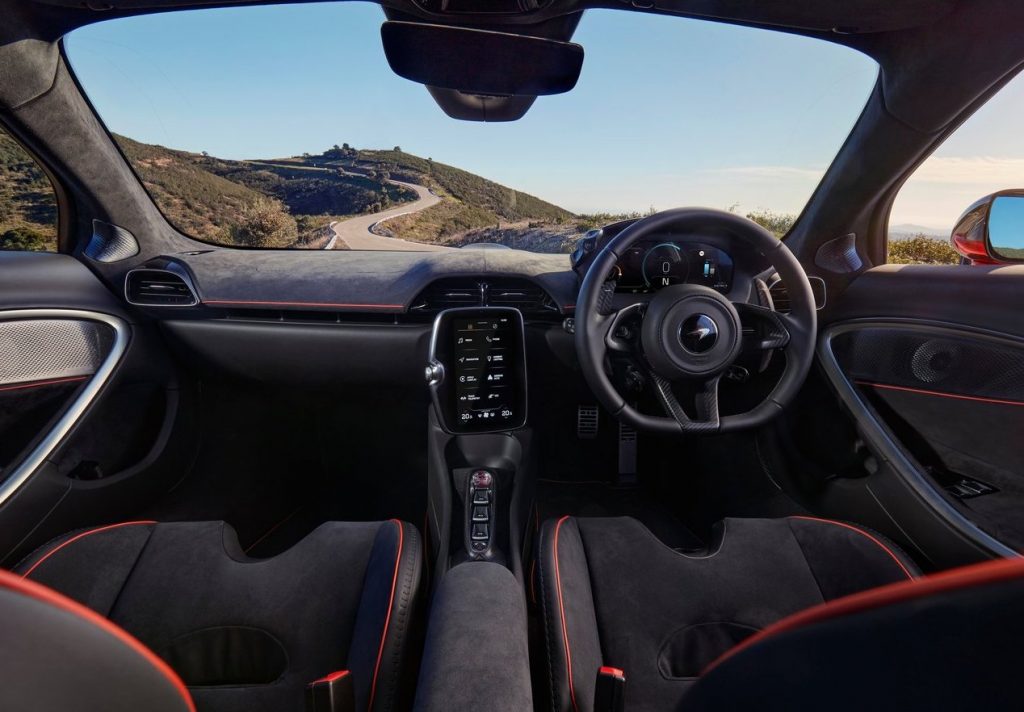
An all-new McLaren infotainment and connectivity system (MIS II) utilises two high-definition screens. The interface is built on all-new software and bespoke hardware to deliver a smartphone level of responsiveness and is also capable of smartphone mirroring. MIS II includes updated versions of familiar McLaren apps including McLaren Track Telemetry and Variable Drift Control, and also features a redesigned navigation map in the instrument cluster which focuses on key information to minimise driver distraction. A stealth mode on the main binnacle hides non-essential content, reducing distractions and promoting full concentration on the road ahead.
MIS II also optionally enables a number of ADAS driver assistance features, including Intelligent Adaptive Cruise Control with Stop/Go; Lane-Departure Warning; High-Beam Assist and Road-Sign Recognition. These and the infotainment features can all be enhanced using OTA update technology. The Artura also features a Bluetooth low-energy vehicle key which detects when the driver is heading towards the vehicle and powers up systems to welcome occupants. This includes ambient, ‘hidden-until-lit’ lighting in the doors, also acting as puddle lamps.
Befitting a car that is all-new and the distillation of more than half a century of McLaren’s expertise and experience in race- and road-car engineering, the Artura introduces a number of technologies for which McLaren has patents pending. These include filings for multiple elements of the MCLA; a patent relating to the use of the E-motor in lieu of a mechanical reverse gear to enable rearwards travel and also allows gearbox length to be reduced; and a patent that covers the innovative yet refreshingly easy to use lightweight adjustment mechanism of the all-new Clubsport seat.
Available to order now from McLaren retailers, with first deliveries to customers commencing in Q3 of this year. There are three further core specifications: Performance, which has a sporting, functional aesthetic; TechLux, where the focus is on the technical luxury that the name suggests; and Vision, which displays a more avant-garde and adventurous look and feel.
Every McLaren Artura comes as standard with a five-year vehicle warranty, a six-year battery warranty and 10-year body warranty.
